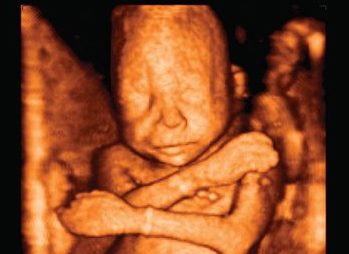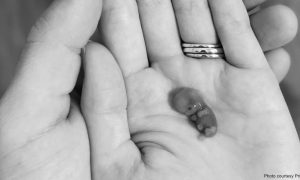Swedish author Vivian Wahlberg wrote the book Memories After Abortion, which contains the stories of women who had abortions and discusses studies on abortion’s aftermath. In the book’s introduction, she reveals that she had a first-hand brush with abortion – an incident that left her deeply troubled.
She was training to become a nurse and was called upon to assist in an abortion done at 22 weeks. By 22 weeks, a preborn baby can respond to sounds and his or her eyes can detect light. The baby has fingernails and toenails as well as unique fingerprints. Hair is beginning to grow on the baby’s scalp. Many scientists believe the baby can feel pain at this stage.
Wahlberg describes the abortion:
[T]he operation was performed through an abdominal incision. I vividly remember the moment when the doctor lifted out the whimpering baby and put it into a receptacle, which he then passed to me with instructions to put it on the fridge. Often I would go to the fridge and open the door slightly, full of wonder and feelings of ambivalence towards the tiny baby – who was later collected with the rest of the department’s biological waste.
The living baby was placed in a refrigerator to die of cold. Even though he or she was alive outside of the womb, no care was given. Very few babies have survived being born at 22 weeks, but it is not unheard of. The youngest premature baby to survive was 21 weeks and 6 days at birth. Although there was a chance that this child could have lived, he or she was never given the opportunity. The baby was torn from the safety of his mother’s womb and died alone, shivering in the cold, while the people who took his life ignored him.
In this video, Dr. Anthony Levatino describes what happens during a typical 2nd trimester surgical abortion on children between 13 and 24 weeks gestation:
The very next week after witnessing that child being left to die, Wahlberg was back training in the delivery ward. Her very first patient was giving birth to a disabled baby. The child was expected to be born with a clubfoot. When the baby was born, his deformities were more extensive. Wahlberg says:
[I] was fully prepared for the fact that there would be an abnormality. In fact both feet were deformed and even the child’s head was deformed, and much of the brain was missing.
Despite the baby’s condition, this child was wanted. Doctors and nurses immediately fought to save his life.
My clinical teacher had instructed me to immediately follow all of the resuscitation procedures necessary. A pediatrician was called in, oxygen was connected up, alternating hot and cold baths for the infant were prepared, and so on.
Later, Wahlberg reflected on what she had witnessed. Because one child was wanted by his mother, doctors and nurses fought hard to save his life. The unwanted baby was pulled from his mother’s womb and died with no help from the same medical professionals that fought so valiantly to save the other baby. Wahlberg says:
Once again I felt great ambivalence. How can one make such a distinction between children? The first was taken out far too early – an apparently perfect and clearly viable little human being – and was then ignored. The other, born at full term, had such severe defects that any life–supporting measures were doomed to failure. Despite this, every possible resource was used to save this gravely ill and badly deformed child, but not the other healthy, living fetus.
Ever since that time I have tried to answer the question “What in fact is a human being?
Although Wahlberg’s tone is somewhat ablest, her words illustrate the irrationality of legalized abortion. The unwanted baby was killed. Doctors and nurses struggled to save the wanted baby even though the struggle seemed futile. The answer to her question is, they were both human beings. Unfortunately, the life of one of the human beings was considered worthless because he was not wanted. Both babies had the same right to life and were of equal worth. They were both valuable; they both had the right to live. But because Sweden, just like the United States, has accepted legalized abortion, one child was valued and the other one was not. The mother had ultimate power over whether her baby would be treated as a patient or discarded as medical waste. Both lives were precious, but only one was fought for.
Pro-lifers reject the argument that babies are only valuable if they are valued by their mothers. We believe all humans have inherent worth, regardless of how they are viewed by others.
Source: Vivian Wahlberg Memories After Abortion (Oxford: Radcliffe Publishing, 2007) 7








